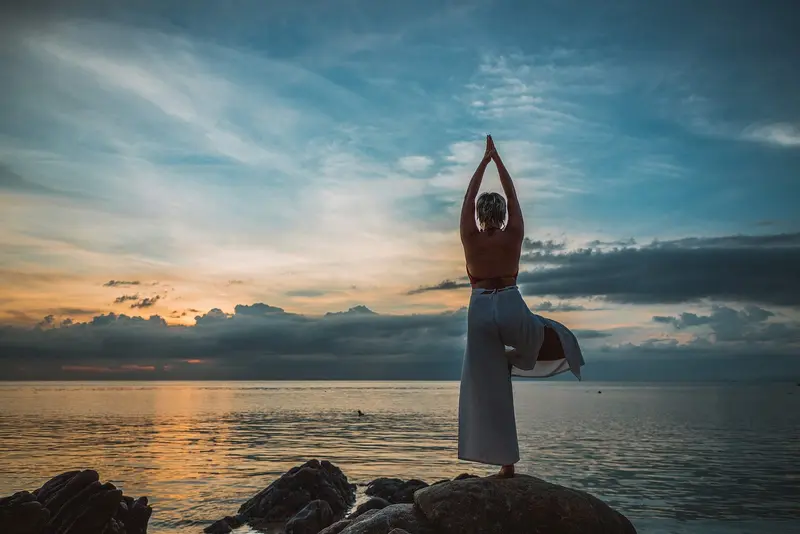Life today is challenging, we work hard, face limitations and stress. Most of us are looking for ways to cope with stress. Yoga is a great way to reduce stress because it combines breathing exercises, asanas and meditation to achieve harmony of body and mind. We will review how yoga can help you reduce stress.
Highlights
- Yoga is an effective way to reduce stress levels, through breathing exercises, asanas (yoga postures), meditation and mindful living.
- The key to success is regularity and regularity in yoga practice.
- Regular practice will help you better realize your potential to achieve peace of mind in a challenging world.
- Try to do breathing exercises, asanas and meditation at least once a day.
- Keep your focus on the present and concentrate on your yoga practice – be aware of your emotions, thoughts and feelings.
Introduction
Yoga is an ancient practice originating in India that can help you reduce stress. Yoga is accessible to everyone, and its benefits are varied. Properly done, yoga supports physical, mental and spiritual health.
The key to achieving peace of mind is the ability to maintain balance in everyday life. Yoga can help you do this because it combines elements of breathing, asanas, meditation and mindfulness. By practicing yoga regularly, you will be able to better manage stress and achieve more peace of mind.
Benefits of yoga practice:
- Improved body fitness and flexibility
- Calming of the mind
- Improved mood and well-being
- Greater awareness of the body and mind
- Relief of pain and tension
- Reduction of stress and anxiety
The practice of yoga teaches us how to get rid of negative thinking and take control of our emotions. Yoga breathing exercises teach us how to improve our circulation and slow down our pace of life. Asanas help to relax the body and calm the mind.
Some ways to practice yoga:
- Hatha yoga: Hatha yoga is the most popular type of yoga. It’s a good option for those starting out in yoga because it has a well-balanced program of asanas, breathing and meditation.
- Iyengar yoga: This form of yoga places great emphasis on precision and detail during asana practice. It is also recommended for therapeutic exercises.
- Vinyasa yoga: This dynamic form of yoga focuses on the smooth performance of asanas. It relies on the coordination of breath with movement.
- Kundalini yoga: This form of yoga focuses on activating Kundalini energy. It activates the body’s energy and allows you to achieve a deep state of relaxation.
Yoga – what is it?
Yoga is an ancient practice that originated in India and consists of breathing exercises, asanas, meditation and philosophy. It is one of the oldest forms of physical and spiritual exercise. The goal of yoga is to achieve harmony of body, mind and spirit through the use of various techniques. Yoga can help you manage stress by:
- Practicing asanas – Asanas are physical postures that are part of yoga. They are designed to strengthen the body and promote the health of the mind. Asanas are effective in reducing stress by allowing you to focus on your body and breath.
- Practice breathing exercises – Breathing exercises are a key component of yoga. Breathing helps reduce stress and facilitates relaxation. Breathing practice contributes to better physical and mental well-being.
- Meditation – Meditation is an important element of yoga. It allows us to better understand ourselves and the world around us. Meditation helps reduce stress levels, calm the mind and find inner balance.
Yoga is an effective method of dealing with stress. It is an excellent way to achieve inner peace in a challenging world. Yoga helps people achieve a balance between body and mind, which translates into stress reduction.
What is yoga’s role in stress reduction?
Yoga is one of the best tools for stress reduction. When you practice yoga, you focus on a combination of body, breath and mindfulness. Yoga provides support for the entire body and mind by performing asanas (yoga postures), breathing exercises and meditation.
Yoga helps combat stress through:
- Body Awareness: By practicing yoga, you can become aware of your body and learn to manage stress.
- Breathing: The breathing techniques used in yoga are a great tool for controlling stress.
- Meditation: Through meditation, you can better understand your thoughts and emotions, which helps reduce stress levels.
- Stretching and relaxation: Yoga helps relax muscles, which helps relieve pain and tension.
The practice of yoga combines movements, breathing and meditation to reduce stress levels in the body. By practicing yoga regularly, you can achieve more peace, inner strength and balance.

Types of yoga techniques for stress reduction
There are many yoga techniques that can help reduce stress. From simple postures to complex sequences with fixed and moving postures. Here are some yoga techniques you can use for stress reduction:
- Asanas: Asanas are yoga postures. Taking them gives you a feeling of calm, tranquility and deep relaxation. Performing asanas regularly can help reduce stress and improve your overall well-being.
- Breathingexercises: Breathing exercises are an important part of yoga. Diaphragmatic breathing is very effective in reducing stress and improving sleep quality. You can try breathing through your nose and controlling your breaths to achieve calmness.
- Meditation: Meditation is an effective technique for reducing stress. With regular meditation, you can experience more peace and inner harmony. You can try meditation with the help of aromatherapy or using relaxation music.
Yoga is excellent for reducing stress and calming your mind. It will help you draw strength and energy from yourself so you can achieve peace and balance in your life.
Breathing exercises
Yoga combines breathing techniques, asanas and meditation to help reduce stress. Breathing exercises are key to achieving this goal.
Breathing is the foundation of yoga. Breathing practice brings balance and calm, and helps manage stress. Many breathing techniques can be used to relax and de-stress.
Learning to breathe is an important part of yoga and includes a number of techniques that can help reduce stress. You can use the following techniques:
- Ujjayi: a breathing technique that involves making a noise as you inhale and exhale.
- Anuloma Viloma: a combination of inhalation and exhalation by holding air on both sides of the nasopharynx.
- Kapalabhati: an intense breathing practice that promotes energy renewal.
- Bhramari: a breathing technique that involves making a sound when the air is released.
Each of the above techniques provides benefits. Try combining them with asanas or meditation to increase the benefits to the body and mind. If you motivate yourself well and practice yoga regularly, you will feel lighter and calmer.
Asanas – yoga postures for stress reduction
Each form of yoga has its own special asanas that allow people to relax and regain calm. Asanas are body positions that work with the breath and focus the mind. Some asanas can help reduce stress, so it’s a good idea to choose a few that are suitable for your lifestyle.
Yoga postures for stress reduction are:
- Janu Sirsasana (position on the knees)
- Kandasana (position with head on the floor)
- Tadasana (tree position)
- Adho Mukha Svanasana (dog position with head down).
- Baddha Konasana (shell position).
These asanas can be practiced for a few minutes every day to achieve the full effect. You can also try meditating after completing a series of asanas to feel calm and inner balance. Yoga is a great way to relax your body and mind and challenge you physically and mentally.
Meditation – reducing stress and restoring peace of mind
Meditation is crucial for stress reduction. It causes feelings of calmness and reduces negative thoughts. Yoga and meditation are correlated because yoga aims to bring the body and mind into balance, while meditation helps in this process.
Meditation requires you to focus on your breaths to achieve inner balance. You can start with sitting meditation – sit comfortably and focus on your breaths. Don’t worry if your mind focuses on your thoughts, just focus on your breath. It may take some time, but as you practice, your mind will become calmer
In yoga, there are many postures and breathing techniques that can help you achieve a state of deep relaxation.
- Savasana, or the position of lying on your back, is an ideal way to achieve deep relaxation.
- Ujjayi is a breathing technique that involves slowing down and controlling your breathing.
- Pratyahara, or cutting yourself off from external stimuli, can help you focus on your inner world.
Yoga and meditation are excellent tools for relaxing the mind. Regular exercise can help you reduce stress and restore a calm mood. It is recommended that you practice yoga 3-5 times a week for maximum benefits. If you have time or budget constraints, you can practice yoga online or look for free courses in your area.

Conscious living – impact on stress reduction
Living in a conscious rhythm is the key to reducing stress levels. Conscious living means looking carefully at yourself, your behavior and the environment around you. Just as physical and breathing exercises are important elements of yoga, so is choosing healthy options for body and spirit. To reap the benefits of yoga, you must start by adopting a mindful living attitude.
Starting a yoga practice can mean a change in your daily schedule. It may be difficult at first, but if you want to see results, you should take the time to practice yoga regularly. It’s important to practice consistently to see lasting benefits. Combine all elements of yoga – physical exercise, breathing and meditation – to achieve complete peace and harmony.
Remember to consider your physical capabilities when performing asanas. Avoid over-exertion and focus on balance, flexibility and relaxation. Also consider your limitations and learn to accept them. Combine your yoga exercises with adequate food and sleep to enjoy the full benefits of conscious living.
Practical tips for performing yoga techniques
Yoga is an ancient practice that can help you reduce stress and regain inner peace. If you practice yoga regularly, you may notice an improvement in your quality of life and physical and mental well-being. One of the most important yoga techniques is diaphragmatic breathing. This breathing technique helps relax muscles and reduce stress. Practicing asanas, or yoga postures, can also help you reduce stress. Below are some techniques you can use to achieve calmness in your life:
- Pranayama – Pranayama is a breathing system that combines deep breathing and breath control.
- Asanas – Asanas are yoga postures that make the body flexible and help clear the mind.
- Meditation – Meditation is a great way to relax and manage stress.
With the practice of yoga, you can enjoy complete peace and harmony. Yoga is an excellent method to reduce stress and harmonize your body and mind. Try different yoga techniques to find the one that works best for you.
Summary
Yoga is an effective tool for stress reduction because it uses a combination of breathing, asanas and meditation to help you achieve harmony of body and mind. Practicing yoga regularly can have a positive effect on your body and mind, reducing stress, improving your mood and providing new relaxation techniques. Here are some ways to reduce stress with yoga:
- Calming breaths: Using calming breathing techniques is a great way to reduce stress. Slow and deep breathing increases the flow of oxygen to the brain, which has a positive effect on your mood.
- Asanas: Yoga postures provide balance between the body and mind. When practicing yoga, your body physically relaxes, which helps remove tension and stress.
- Meditation: Meditation is one of the most effective ways to reduce stress. By using meditation techniques during yoga, you can achieve inner peace and balance.
Practicing yoga can be an amazing thing. It can help you achieve peace of mind in a challenging world. The yogalifestyle.com portal provides you with information and advice on healthy living and how to use yoga to reduce stress. So you can reap the benefits of practicing yoga!
Frequently asked questions
How can yoga help me reduce stress?
Yoga can help reduce stress through breathing techniques, asanas and meditation. Breathing techniques help reduce physical and mental stress levels by providing more oxygen to the body, which in turn affects relaxation. Asanas help strengthen the body and get rid of tension, while meditation is a great way to clear the mind of negative thoughts. By combining these three elements, yoga is an excellent tool for achieving harmony of body and mind.
What exercises should I do?
Yoga is an excellent way to reduce stress, as it combines breathing exercises, asanas and meditation to achieve harmony of body and mind. In particular, yoga techniques should focus on relaxation, reducing stress and restoring mental peace. These techniques include pranayama (breathing exercises), asanas (standing or lying postures), meditation, relaxation and mantra sessions. Perform them regularly to notice the difference!
How often should I practice yoga?
Depending on your needs and skill level, you can learn yoga once a week or daily. The most important thing is to find yoga techniques that will help you reduce stress and restore your peace of mind, and then repeat them regularly. These can include breathing exercises, asanas (yoga postures) and meditation.
Are there any proven benefits of yoga practice?
Yes, there are proven benefits of yoga practice. Yoga can help reduce stress and restore peace of mind, through breathing techniques, asanas and meditation. When practicing yoga, it is important to maintain balance, calmness and focus on the body. These techniques help to relax the body and mind, allowing you to feel calm.
What are the health benefits of practicing yoga regularly?
Doing yoga exercises regularly has many health benefits. Practicing yoga can help you reduce stress, alleviate circulation problems, increase flexibility in your muscles and joints, improve concentration and facilitate relaxation. Yoga can also strengthen your body, help you achieve better posture and increase your body awareness. Using stress-reducing yoga techniques such as diaphragmatic breathing, asanas and meditation, you can achieve peace and harmony of mind.
What is the best way to start a yoga practice?
The best way to start a yoga practice is to focus on yoga techniques that will help you reduce stress and restore peace of mind. For example, diaphragmatic breathing (ujjayi), relaxation asanas (savasana), meditation and mindful yoga practice (mindful yoga) are just some of the techniques that will help you achieve a state of harmony of body and mind.
Can I practice yoga without equipment?
Yes, you can practice yoga without equipment. Yoga techniques such as diaphragmatic breathing, asanas and meditation are enough to achieve peace of mind. These techniques can easily be done at home or outdoors, making yoga a great way to manage stress. We recommend practicing these types of techniques on a regular basis to positively impact stress reduction and improve your mood.
Are there easy yoga exercises I can do at home?
Yes, yoga is accessible to everyone and you don’t have to be a professional yogi to have the benefits of the practice. There are many easy yoga exercises that can be done at home. Focus on stress-reducing yoga techniques, such as pranayama and asanas, and techniques that restore peace of mind, such as meditation and relaxation. Feeling the flow of energy in the body through the breath can help you achieve greater peace and harmony.

